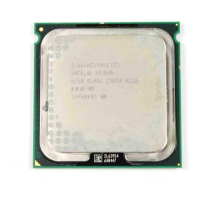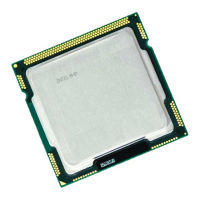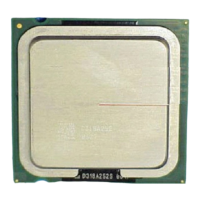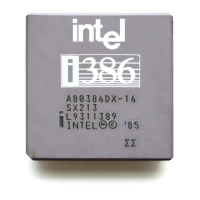Quality and Reliability Requirements
82 Dual-Core Intel® Xeon® Processor 5100 Series Thermal/Mechanical Design Guide
Note: In the case of a discrepancy, information in the most recent LGA771 Socket Mechanical Design
Guidelines supersedes that in the Table D-1 above.
D.1.2.2 Recommended Test Sequence
Each test sequence should start with components (that is, baseboard,
heatsink assembly, and so forth) that have not been previously submitted to any
reliability testing.
The test sequence should always start with a visual inspection after assembly, and
BIOS/Processor/memory test. The stress test should be then followed by a visual
inspection and then BIOS/Processor/memory test.
D.1.2.3 Post-Test Pass Criteria
The post-test pass criteria are:
1. No significant physical damage to the heatsink and retention hardware.
Table D-1. Use Conditions Environment
Use Environment
Speculative Stress
Condition
Example Use
Condition
Example 7-Yr
Stress Equiv.
Example 10-
Yr Stress
Equiv.
Shipping and
Handling
Mechanical Shock
• System-level
•Unpackaged
•Trapezoidal
• 25 g
• velocity change is based
on packaged weight
Total of 12
drops per
system:
•2 drops per
axis
•± direction
n/a n/a
Product
Weight (lbs)
Non-
palletized
Product
Velocity
Change
†
(in/
sec)
< 20 lbs
20 to > 40
40 to > 80
80 to < 100
100 to <
120
≥120
250
225
205
175
145
125
†
Change in velocity is based
upon a 0.5 coefficient of
restitution.
Shipping and
Handling
Random Vibration
• System Level
•Unpackaged
• 5 Hz to 500 Hz
• 2.20 g RMS random
• 5 Hz @ .001 g
2
/Hz to
20 Hz @ 0.01 g
2
/Hz
(slope up)
• 20 Hz to 500 Hz @ 0.01
g
2
/Hz (flat)
• Random control limit
tolerance is ± 3 dB
Total per
system:
• 10 minutes
per axis
•3 axes
n/a n/a

